A Practical Approach to Finding Low-Cost Internet for Seniors
In today’s connected world, having access to reliable and affordable internet is crucial, especially for seniors who benefit significantly from digital connections allowing them to stay in touch with family, manage health care, access news, and even enjoy entertainment. However, the cost of internet service can be a significant barrier. This article explores practical ways for seniors to access cost-effective internet services, providing real value through actionable advice and specific recommendations.

Understanding the Market and Senior Needs
Before diving into how to find inexpensive internet options, it’s important to understand why seniors are often paying more than necessary. Seniors are less likely to switch providers or negotiate rates, often sticking with the same provider for years without questioning rising costs. A 2021 report by the Federal Communications Commission (FCC) highlighted that only a minority of seniors opt for switching plans or negotiating new terms, which can lead to overpaying for services not fully utilized.
Research and Compare Plans
The first step in reducing internet costs is thorough research. Seniors should compare plans from different providers in their area. Websites like BroadbandNow or the FCC’s National Broadband Map can help identify local providers. It’s important to compare not just prices but also contract terms, speeds, data caps, reliability ratings, and customer service reviews. For instance, a plan costing $40 per month may seem inexpensive but could come with low speed and poor customer service, which might not meet the need for video calls with family or streaming services.
Leverage Age-Based Discounts
Several internet providers offer discounts specifically for seniors. For example, Spectrum has Internet Assist, and Comcast’s Internet Essentials is marketed to low-income families and seniors. These plans often provide adequate speeds for everyday use like emailing, web browsing, and video calling at a fraction of the cost of standard plans. As of 2022, these plans can range from $10 to $25 per month, significantly lower than the average broadband plan cost of around $60 per month in the USA.
Government Assistance Programs
The federal government provides programs to assist seniors with internet costs. The Affordable Connectivity Program (ACP), created under the FCC, offers up to $30 per month towards internet services for qualifying low-income households, and up to $75 per month for households on tribal lands. This initiative is particularly useful for seniors facing financial constraints, helping reduce their bills substantially. Seniors can apply for these benefits through their internet service provider or directly via the government’s ACP website.
Consider Mobile Solutions
For seniors who use limited data, considering mobile solutions such as hotspots or data-inclusive mobile plans might be more cost-effective. Some mobile providers offer plans with added perks for seniors. For instance, T-Mobile’s Unlimited 55+ plan provides unlimited talk, text, and data for prices that are competitive with many home internet services.
Bundle Services to Save
If a senior is already paying for cable TV or landline service, bundling these with internet might offer savings. Providers like AT&T, Verizon, and others typically offer discounts to customers who bundle two or more services. Evaluating the total cost of these bundled packages can sometimes reveal surprising savings compared to purchasing services separately.
Engage in Negotiations
One often overlooked approach is simply asking for a better deal. Seniors can sometimes negotiate a better rate by calling customer service, especially when armed with offers from competitors as leverage. Mentioning a competitive plan or expressing a financial constraint can sometimes prompt the provider to offer discounts or match prices.
Alternative Providers and Technologies
Exploring alternative providers like local ISPs (Internet Service Providers) or newer technologies can yield unexpected benefits. Options like satellite internet, municipal broadband, or fixed wireless might provide competitive rates, more personalized customer service, and adequate speeds for general internet needs. Additionally, the emergence of low-earth orbit satellite services like Starlink is changing the landscape with new offerings.
Check for Community Programs
Some communities offer free or reduced-cost internet services through public libraries, community centers, or city-sponsored initiatives. These programs can be excellent resources, particularly for seniors who use the internet sparingly.
Conclusion
In conclusion, affordable internet access for seniors can be achieved through a combination of government assistance, special discount plans, effective negotiation, and choosing the right service type. Seniors—and their caregivers or family members—should assess internet needs, research options thoroughly, and not hesitate to ask for discounts or consider alternative solutions. The digital world offers immense benefits, and navigating it should not come at a prohibitive cost.







Recent Comments